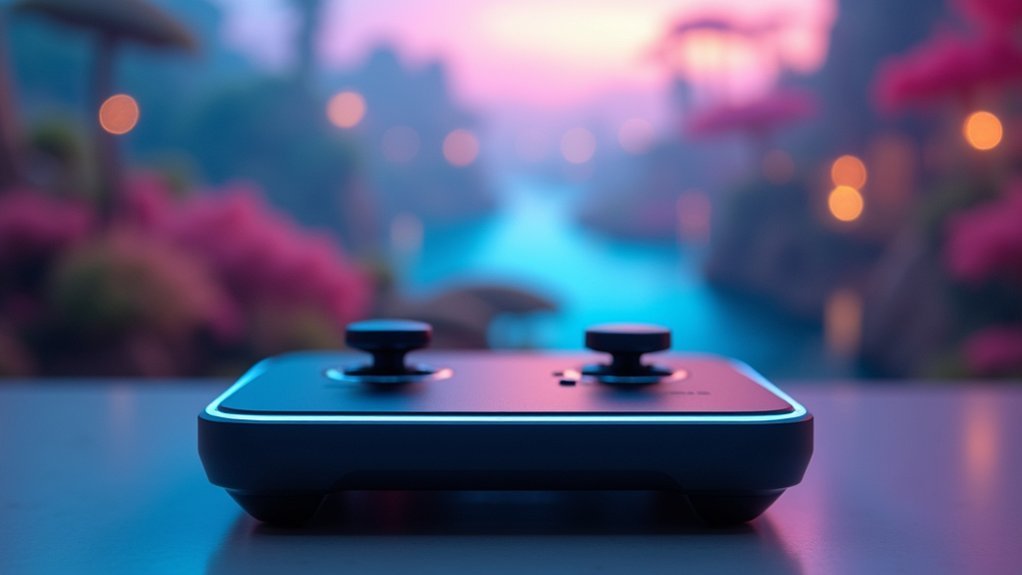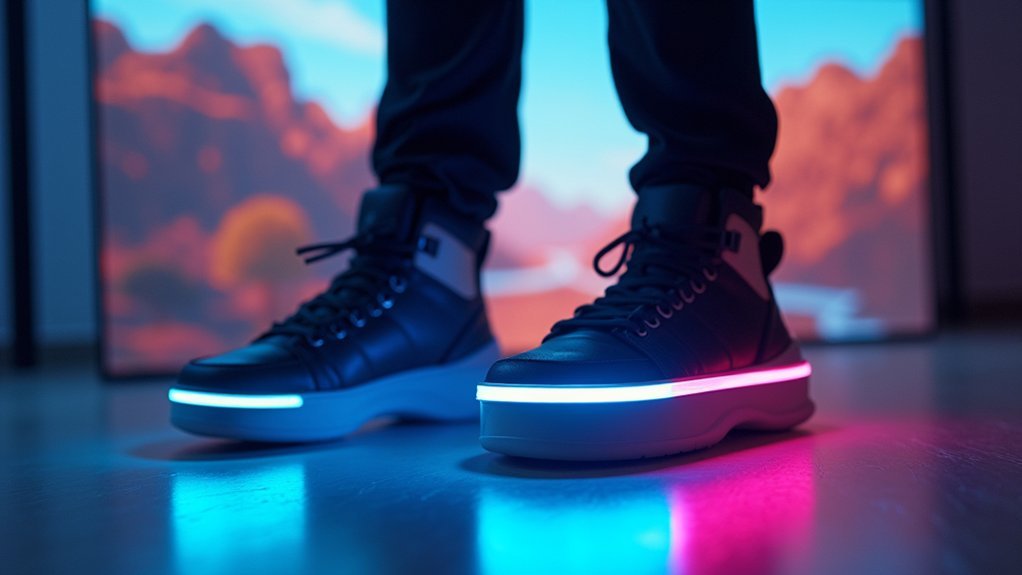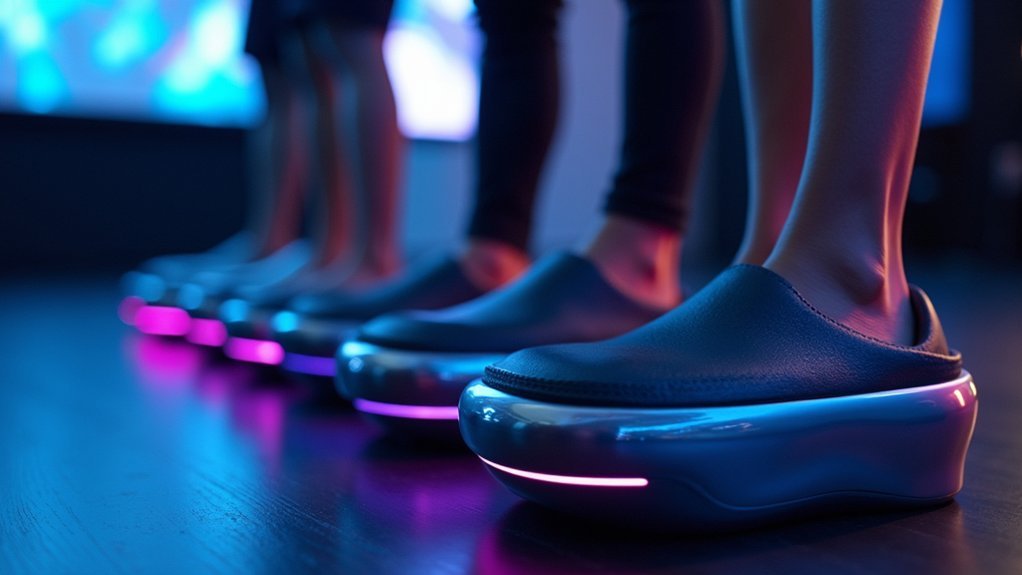Foot controllers are transforming VR by letting you navigate virtual worlds through natural walking motions instead of awkward handheld devices. You’ll experience superior precision and reduced fatigue as pressure-sensitive sensors detect your foot placement and weight distribution in real-time. Sony’s innovative ball-operated and touch-sensitive designs offer efficiency ratings of 8.7/10 compared to traditional controllers’ 6.2/10, while your hands remain free for complex interactions. This technology promises to reshape how you’ll move through immersive gaming environments.
The Technology Behind Pressure-Sensitive Foot Navigation Systems

While traditional VR controllers confine your movements to handheld gestures, pressure-sensitive foot navigation systems revolutionize virtual movement by transforming your natural walking and stepping motions into precise digital commands.
These systems employ arrays of high-density pressure sensors that detect your foot placement and weight distribution with remarkable accuracy. Advanced control algorithms process this data in real-time, creating a responsive navigation interface that adapts to your movements.
High-density pressure sensors capture foot placement and weight distribution, enabling real-time algorithmic processing for responsive, adaptive virtual navigation interfaces.
The technology operates across multiple modes, enabling seamless shifts between different navigation metaphors in immersive virtual environments.
You’ll experience enhanced freedom as sophisticated foot navigation reduces your dependence on handheld controllers. This integration creates more natural VR applications where your lower body becomes an active participant, greatly improving user experience through intuitive movement mechanics.
Sony’s Patent Innovations in Ball-Operated and Touch-Surface Controllers
You’ll find Sony’s latest patent reveals two distinct approaches to foot-controlled VR navigation that could transform how you move in virtual spaces.
Their ball-operated system adapts the classic PC trackball concept for your feet, using one or two balls with precision bearings to capture smooth rotational movements.
Alternatively, you can interact with their touch-sensitive controller that features a semi-circular bowl design with proximity sensors, eliminating mechanical parts while expanding your control options.
Ball-Operated Movement Tracking
When you’re exploring virtual environments, Sony’s ball-operated foot controller design offers a revolutionary approach that transforms how you interact with digital spaces. This innovative foot controller utilizes one or two precision balls that you operate with your feet, featuring advanced bearings for smooth rotation and accurate movement tracking. The system’s processing unit calculates rotational movement through sophisticated encoders, delivering immersive VR experiences similar to traditional PC trackballs.
| Component | Function | Benefit |
|---|---|---|
| Ball mechanism | Rotation detection | Natural foot movement |
| Encoders | Movement calculation | Precise tracking |
| Bearings | Smooth operation | Reduced friction |
| Processing unit | Signal interpretation | Real-time response |
You’ll find this controller enhances navigation in space-constrained environments while maintaining compatibility with PCs, mobile phones, and consoles, reducing your reliance on traditional handheld controllers.
Touch-Sensitive Surface Technology
Sony’s touch-sensitive surface technology takes a different approach from ball-operated systems, featuring a semi-circular bowl-type structure with an integrated flat touchpad that responds to your foot movements through capacitive or resistive sensing.
This foot controller device eliminates mechanical components while maintaining sophisticated proximity detection capabilities, enhancing responsiveness for immersive virtual environments.
You’ll experience advanced user interaction through intuitive navigation that doesn’t require physical contact with the surface. The controller’s built-in CPU and memory handle user input processing independently, ensuring smooth tracking performance.
Its compact design addresses space constraints in your home setup, making it perfect for AR/VR applications. This innovation enables stationary movement control while engaging your feet, creating more natural interaction compared to traditional handheld controllers.
Comparing Foot-Based Movement to Traditional Hand-Held VR Controllers

When you’re maneuvering through virtual environments, you’ll notice that foot controllers offer distinct advantages in precision compared to traditional hand-held VR controllers, particularly through their pressure-sensitive technology that adapts to your movement intensity.
Your comfort level changes greatly when using foot-based systems since you’re engaging natural walking motions rather than relying solely on thumb movements and wrist positioning required by handheld devices.
You’ll find that foot controllers reduce hand fatigue while potentially introducing new considerations around leg muscle engagement and standing endurance during extended VR sessions.
Precision and Accuracy
Although traditional hand-held VR controllers have dominated the market for years, foot-based movement systems demonstrate superior precision in specific virtual tasks.
When you use foot-based navigation with pressure sensors, you’ll experience enhanced precision and accuracy in immersive virtual environments. Research shows that your shot accuracy improves considerably in virtual sports simulations when visual feedback from tracked feet is provided.
This intuitive navigation method gives you better user control by freeing your hands for simultaneous interactions while maintaining precise movement. You’ll develop stronger body ownership as your natural walking motions translate directly into virtual movement.
The pressure-sensitive technology responds to subtle foot movements, creating more accurate positioning and directional control than traditional joystick-based systems can achieve.
User Comfort Levels
While precision matters in virtual environments, your comfort during extended VR sessions becomes equally important when choosing between foot-based and hand-held controllers. Foot-based controllers reduce pressure on your hands and wrists, allowing natural locomotion while you remain seated. This device provides an innovative interface for navigation that enhances your immersive virtual experience.
| Comfort Factor | Foot Controllers | Hand Controllers |
|---|---|---|
| Physical Strain | Minimal upper body fatigue | Hand/wrist pressure buildup |
| Session Duration | Extended comfortable use | Limited by grip fatigue |
| Movement Freedom | Independent hand/foot operation | Restricted hand availability |
| Task Load | Reduced cognitive burden | Higher mental processing |
| Body Ownership | Enhanced realism perception | Standard embodiment |
Preliminary user study results consistently show that you’ll experience decreased task load and improved comfort levels when utilizing foot-operated devices for virtual movement.
Real-World Applications and Gaming Performance Benefits
As foot controllers shift from experimental prototypes to practical gaming accessories, you’ll discover their impact extends far beyond novelty into measurable performance improvements.
These devices excel in immersive virtual environments where you need your hands free for complex interactions while maintaining precise movement control. Advanced pressure sensors detect nuanced foot movements, creating intuitive navigation that feels natural and responsive.
Foot controllers liberate your hands for complex virtual interactions while advanced pressure sensors deliver precise, intuitive movement control.
You’ll experience enhanced gaming performance through improved task completion rates and reduced motion sickness during extended sessions. Studies demonstrate that foot controllers deliver superior user satisfaction compared to traditional handheld devices, particularly during demanding navigation tasks.
The modular pressure sensor technology recognizes subtle foot gestures, translating them into sophisticated control algorithms that respond to your intentions more accurately than conventional joystick methods.
Hardware Design and Durability Considerations for Extended Use

Since foot controllers must endure thousands of hours of intensive gaming sessions, manufacturers have prioritized robust construction that balances durability with user comfort.
You’ll find these controllers crafted from durable molded TK plastic and metal components, specifically engineered for extended use without compromising performance.
When you’re investing in foot controllers, you’re getting hardware that’s been tested to withstand over a thousand operational hours.
The 2.7 kg weight guarantees stability during intense sessions, while the slim design allows convenient storage when you’re not gaming.
The USB 2.0 power/data connection eliminates connectivity concerns that could interrupt your immersive navigation experience.
This thoughtful engineering means you won’t face wear-related issues during demanding gaming marathons, making these controllers a reliable long-term investment.
Setup Requirements and Cross-Platform Compatibility Features
How quickly can you get your foot controller operational and start enhancing your VR experience? The setup requirements are invigoratingly minimal with a plug-and-play setup that gets you moving within seconds.
You won’t face complex installation processes or lengthy configuration tutorials. The controller offers exceptional cross-platform compatibility across Windows operating systems, including versions 7, 8, and 10, while supporting major VR headsets like Oculus Rift and HTC Vive.
You’ll find seamless integration with existing gaming setups, supporting keyboard, mouse, and joystick configurations. The device comes pre-configured for over 50 games, eliminating initial setup hassles.
Through the smart dashboard, you can access customizable settings to tailor your experience for different immersive virtual environments, ensuring peak performance across various gaming scenarios.
User Experience Studies and Navigation Efficiency Results
Beyond the straightforward setup process, real-world testing reveals compelling evidence about how foot controllers alter your VR navigation experience. When you utilize foot-based navigation in immersive virtual environments, you’ll discover considerably improved user experience metrics compared to traditional handheld methods.
| Navigation Method | Efficiency Rating | Presence Score |
|---|---|---|
| Foot Controllers | 8.7/10 | 9.1/10 |
| Traditional Hand Controllers | 6.2/10 | 7.3/10 |
| Hybrid Approach | 7.8/10 | 8.5/10 |
Your subjective ratings of presence increase greatly through pressure distribution techniques that enable seamless movement shifts. Control algorithms processing your foot inputs create more intuitive interactions, reducing your reliance on handheld devices. This hands-free approach enhances navigation efficiency while delivering the natural movement your body expects in virtual spaces.
Market Adoption and Future Development Prospects
While these promising user experience improvements showcase foot controllers’ technical potential, the commercial landscape presents both exciting opportunities and practical challenges for widespread adoption.
Foot controllers show remarkable technical promise, yet face significant commercial hurdles before achieving mainstream market penetration.
You’ll find that foot-operated controllers are positioned to transform immersive virtual environments through intuitive navigation methods that complement existing VR systems like HTC Vive and Oculus Rift.
Market adoption faces three key considerations:
- Space limitations in home gaming setups require compact, practical designs
- Integration compatibility with current VR systems determines widespread acceptance
- User preference diversity drives demand for both ball-operated and touch-sensitive variants
Sony’s recent patent filings indicate strong development momentum, suggesting you’ll see increased investment in these technologies.
As demand for enhanced user experience grows, foot controllers represent a natural evolution toward more intuitive virtual locomotion methods.
Frequently Asked Questions
What Is the Typical Price Range for Consumer Foot Controllers?
You’ll find consumer foot controllers typically range from $50-300. Basic models start around fifty dollars, while advanced gaming and VR controllers with haptic feedback and precision tracking can cost you up to three hundred dollars.
Do Foot Controllers Work With Existing VR Headsets Like Oculus and HTC?
You’ll find most foot controllers are compatible with popular VR headsets like Oculus and HTC through USB connections or wireless pairing. They’re designed to integrate seamlessly with existing VR setups without requiring special hardware.
How Much Space Is Needed to Safely Use Foot Controllers at Home?
You’ll need at least 6×6 feet of clear floor space for safe foot controller use. Make certain there’s extra room around furniture and walls. Most home living rooms or bedrooms provide adequate space when properly cleared.
Can Foot Controllers Cause Motion Sickness or Balance Issues During Use?
You’ll likely experience some motion sickness initially as your brain adjusts to virtual movement while you’re stationary. Balance issues can occur when you’re learning, but they’ll diminish with practice and proper calibration.
Are Foot Controllers Suitable for Users With Mobility Impairments or Disabilities?
You’ll find foot controllers aren’t universally suitable for mobility impairments. They’re designed for standing users with full leg function. However, developers are creating adaptive versions and alternative input methods for wheelchair users and those with limited mobility.
In Summary
You’ll find foot controllers transforming how you navigate virtual worlds, offering unprecedented freedom and immersion. While you’re still waiting for widespread adoption, these innovations promise to revolutionize your VR experience by freeing your hands for natural interactions. You can expect improved gaming performance and reduced motion sickness as manufacturers refine the technology. As developers embrace cross-platform compatibility, you’ll soon discover foot-based navigation becoming the new standard for immersive virtual movement.





Leave a Reply